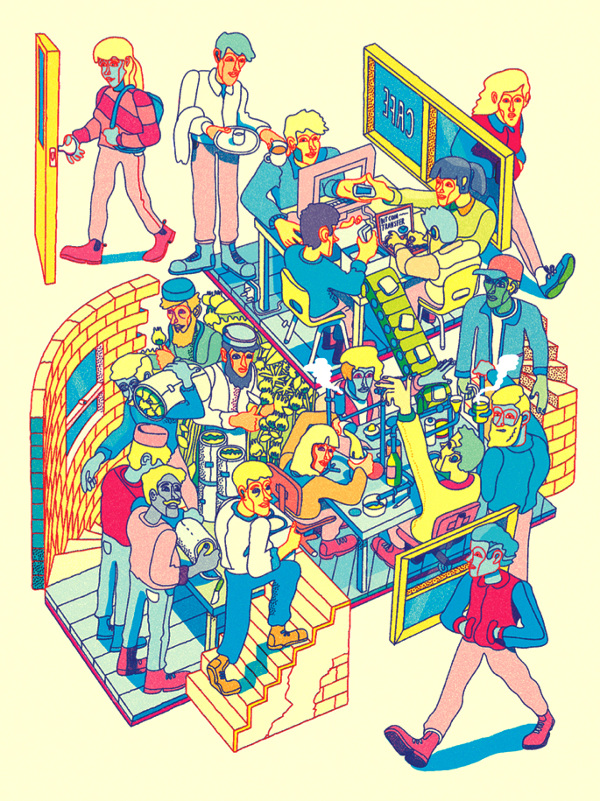Trip Advisor
As with pretty much everything else, the impact the internet has had on the narcotic trade over the past decade is significant, but it’s what comes next that’s really interesting.

When recreational drugs first became popular in the 1960s and 1970s, they were enjoyed mostly by the well-off. Champagne parties were nothing without a bowl of cocaine on the table, the hectic lifestyles of rock stars were often powered by speed pills, and cannabis was something that intellectual, bohemian types smoked to open their minds. Fast forward half a century and we have a drugs war that’s out of control, clandestine chemistry labs dotted around the world, new legal highs popping up regularly, an addiction epidemic and a thriving online drugs bazaar worth $1.2 billion over just two years.
Times have indeed changed. Drug networks used to be founded upon a mix of cartel business ethics, ruthless gang violence and corrupt police. Now these have been replaced with an internet connection, vacuum packing and decentralised electronic currencies. While it’s true that advances in technology have given rise to many drug-dealing operations, they’ve also opened the floodgates to a new generation of tech-savvy drug barons.
The most significant technological advances to revolutionise the drugs underworld, though, are not moisture barrier bags, the Los Zetas cartel’s radio system, or even narco-submarines, but something much more mainstream – the internet. With the rise of the web, the drugs marketplace has been able to spread its reach as never before. Legal highs, for example, would undoubtedly still be an underground alternative for seasoned drug users if it wasn’t for the internet.
As it is, legal highs have exploded on the UK drugs market in the past five years. In 2009, the United Nations Office on Drugs and Crime 2013 World Drug Report concluded that there were around 166 known legal highs on the market. By 2012 a reported 251 were available, with new ones cropping up regularly. The report described the new struggles faced by the international drug control system in coping with the unprecedented speed with which new legal highs are appearing. It noted that: “while new harmful substances have been emerging with unfailing regularity on the drug scene, the international drug control system is floundering, for the first time, under the speed and creativity of the phenomenon [of legal highs]”.
The problem is that legal highs are incredibly easy to manufacture. Producers take an already illegal drug such as ecstasy and alter the molecular structure slightly. This makes the substance a new, unregulated one that still has a similar high to its illegal counterpart. These altered drugs are known as “analogues”. The analogue formula is then outsourced to a drugs laboratory, usually based in China, where it’s mass produced and then sent back to the creator, for a fee. The new, unregulated and ostensibly “safe” drug, often labelled as plant feed “not for human consumption”, can quickly flood the market, usually using names that will catch the eyes of the youth who take them. Summer Love, Champagne Powder and Punk Plus are examples of just a few legal highs widely available on the internet.
The fact that these drugs are so easily tampered with can make them extremely volatile. In 2012 a reported 52 people died through taking legal highs in England and Wales, up from 29 the year before – a 44% increase in legal high-related deaths in one year. With the “legal high” tag, not only are these drugs easy to get hold of, but knowledge of them is traded freely on internet forums such as Party Vibe and TripMe. Advice on how experiences differ from substance to substance, or what combinations should be avoided, can be found on any number of websites.
To understand how easy it is to create these dangerous new legal highs, Mike Power, author of Drugs 2.0: The Web Revolution That’s Changing How The World Gets High, decided to go through the process himself. “All I needed to make my own legal high was a mobile phone, a few hundred quid, an internet connection, and a friendly attitude,” he explains. “The net has democratised access to chemical synthesis, research and experimentation, and has meant we can outsource the production of drugs overseas to China – just as we have with many other areas of manufacturing.” Within two months, Power had made his very own legal high.
Legal highs, however, are just the beginning of home- made chemical experimentation. Power believes the future holds only more technical ingenuity to be made use of by the drugs world. “Chemically, I think we’ll see greater and riskier innovation as increasingly super-potent and novel drugs are engineered to outsmart the law,” he says. “Also, we will see ever-more futile attempts to tackle the trade in online drug markets such as Silk Road, and a greater increase in state surveillance of our digital and physical communications.”
Silk Road is a hidden online drugs marketplace run by Dread Pirate Roberts, which the FBI seized in October 2013. While not the be-all-and-end-all of online drug trading (1997 saw the first online drugs trade/ manufacturing platform in a forum known as The Hive) Silk Road paved the way for the future of online drug dealing and had been vital to the industry since it opened for business in 2011. Running on the Deep Web – the almost untraceable internet-within-the-internet – and utilising the untraceable digital currency, Bitcoin, the narcotics trade on Silk Road thrived.
Being an unregulated, decentralised and mostly anonymous electronic “cryptocurrency” – in the sense that it is almost untraceable – the marketplace became home to roughly 0.5% of all Bitcoin transactions, and unarguably boosted the libertarian-favoured currency into the wider zeitgeist. In fact, when the online drugs bazaar was shut down, the value of Bitcoin actually dropped by 15%, before resuming its unprecedented ascent in value.
As turbulent as Bitcoin is, it rose in value from £3 in April 2012 to a high of £144 in April 2013. At the same time, Silk Road’s inventory grew enormously, encompassing everything from uncut Columbian cocaine to potent black tar heroin. Part of Silk Road’s success was that it enabled drug dealers to ply their product under the guise of a brand. The ratings system, akin to that used by eBay, ultimately decided who was a “reputable” drugs vendor with the best merchandise. Dealers on Silk Road also had a unique interaction with their clients via the forums. This presented a new breed of drug dealers, ones who were concerned with providing a service to their customers.
147 million people – about 2.5% of the world’s population – consume cannabis every year, according to the World Health Organization
One vendor, introduced only as Red, used to head one of Silk Road’s biggest drug-dealing teams (in the top 9% of all vendors, before the shut-down). “We pride ourselves on sourcing the highest quality products, and go to extreme lengths to do so,” he says. “We are passionate about providing people the choice to enjoy quality, natural substances, without the risk of being ripped off, harmed, or sold crap.” Red and his team sold hash, opium, acid and various other drugs. His team went to great lengths to maintain the reputation of their brand and claim to have provided for everyone in the chain of their drugs network.
“The argument about impoverished farmers forced to work plantations doesn’t cut it with my team,” he says. “We source direct; we have excellent relationships with our suppliers all over the world; we visit them regularly and they live a whole lot better thanks to our business. They have a higher quality of life knowing that they can count on monthly business from us.”
Arguably, for this new type of drug dealer to exist, the advanced security measures and improved technology that the internet has provided had to exist first. The digital age has allowed for this new inventive streak in the drugs market, with a future that will almost certainly provide even more ingenuity.
With the introduction of 3D printing, for example, there’s already talk of turning the new invention into a home-based pharmacy. A concept created by Professor Lee Cronin of Glasgow University would see drug consumers buying what is in effect an “ink” cartridge wired with the ingredients of any given drug. Once the cartridge is purchased, the process to create this drug would be downloaded and programmed into your printer, allowing it to literally “print” instant drugs without ever having to set foot outside your home.
UN estimates the value of the global illegal drugs market on $400 billion per year
But chemicals themselves may even become obsolete when it comes to getting high in the future. Some futurists believe that we will all be getting our drugs via nanoparticles and biological proteins. The particles could be manufactured to deliver electromagnetic stimulation to the user, which would trigger a psychedelic state, conjuring the necessary chemicals that lie dormant inside the brain. According to futurologist Dr Ian Pearson: “Some of these [futuristic drugs] will be used in conjunction with smart release mechanisms and with transcranial magnetic stimulation, or TMS, using strong magnetic fields to inhibit or modify the operation of certain brain regions.”
“So, a future scenario for typical drug use might be a partygoer swallowing a drug before they go to the club, and feeling no effects at all until later in the evening, when the DJ decides the atmosphere is about right and then instructs all the smart drugs to ‘activate’. Everyone would experience the effects of their drugs in synch with each other. The TMS would effectively disable certain parts of the brain and enhance others, making the effects of the drugs more interesting.”
While this may seem a distant reality, there are already “binaural beats” which claim to put the listener into a hypnotic or altered state, akin to being on “digital drugs”, some say. Although the science behind them is flimsy, there’re already calls for them to be made illegal in Dubai.
As dramatic as it all sounds, legal highs, online drug bazaars and all the technology that makes them possible, are not bizarre phenomena. They’re simply the product of 21st-century technological innovation. For every sanction that’s stamped on drugs, there’s a Deep Web pioneer or clandestine chemist out there to bypass it. The people taking, trading and creating these drugs in 2014 are, at heart, the same as any other modern era. They’re simply utilising the tools they have to hand. With technology comes progress, and we shouldn’t be surprised that the drugs market is not immune to this rule.


